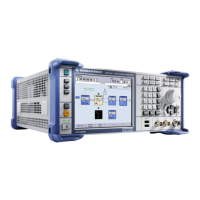Instrument Function
R&S
®
SMBV100A
331Operating Manual 1176.8016.02 ─ 17
Figure 5-21: Connection of several R&S SMBVs for synchronous signal generation
Some applications require a common external trigger source for all instruments. The
connections necessary for this case are not shown on figure above and not considered
in this description. The following sections assume the default situation, i.e. that the
master instrument provides the slaves with its internal trigger signal.
Configuring Several R&S SMBVs for Precise Synchronous Signal Generation
After the instruments had been connected as described in "Connecting Several R&S
SMBVs for Precise Synchronous Signal Generation" on page 330 the instruments have
to be configured.
The synchronization settings are available in the "Clock Settings" section of the "Cus-
tom Digital Modulation" menu, "ARB" menu and in each of the "Clock Settings" menus
of the installed digital standards. The "Clock Settings" menu are described in the "Trig-
ger/Marker/Clock Settings" on page 388 and in the respectively section "Trigger/
Marker/Clock" of the installed digital standards.
To easy the configuration, an automatically adjustment of the required synchronization
settings is provided.
Step 1: Adjust Phase and Level
► Refer to the Application Note 1GP67 for a detailed description on how to adjust the
phase and level settings manually or by using the software tool PhaseTracker.
Step 2: Configure Master Instrument
For working in master-slave synchronous mode, configure the master instrument as
follow:
1. Adjust the baseband settings (e.g. "Custom Digital Modulation" or "ARB") as
required and activate signal generation.
2. Set the "Synch Mode" to Sync Master.
Baseband Signal - Baseband Block

